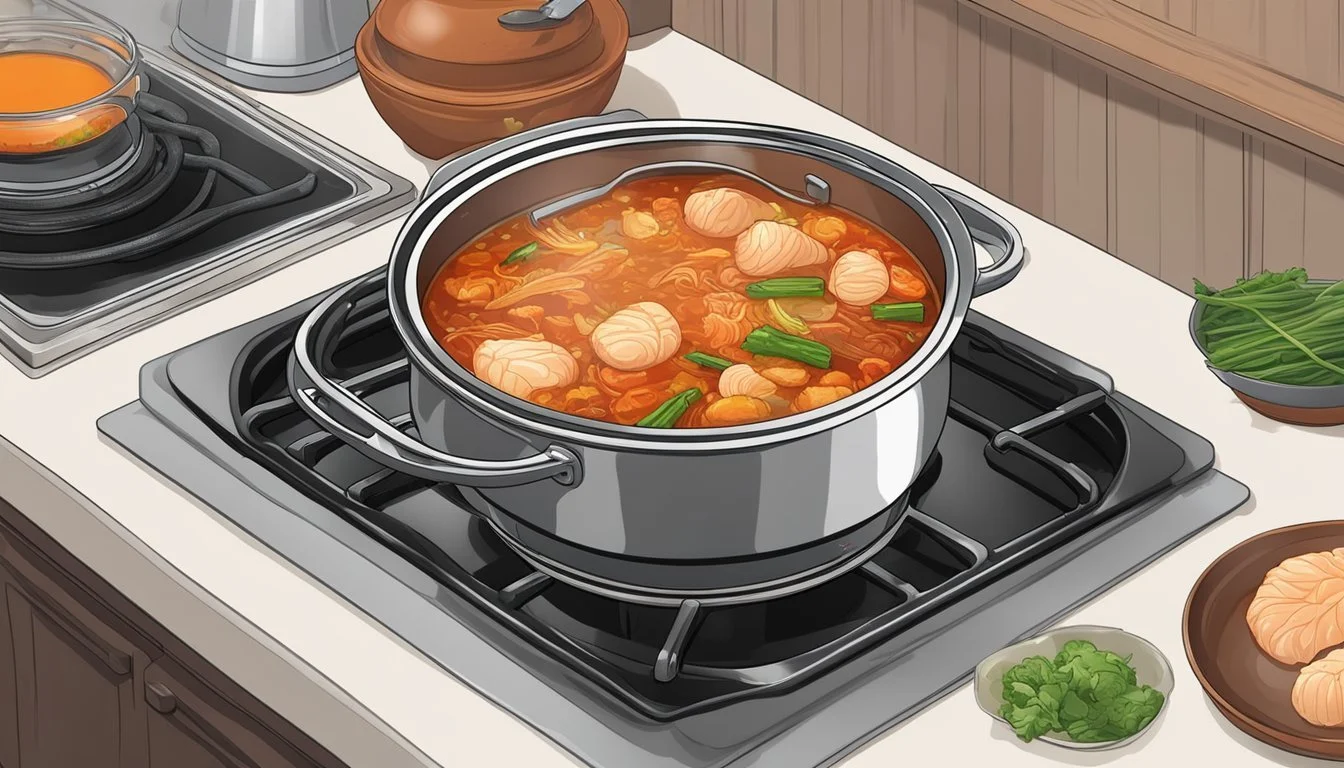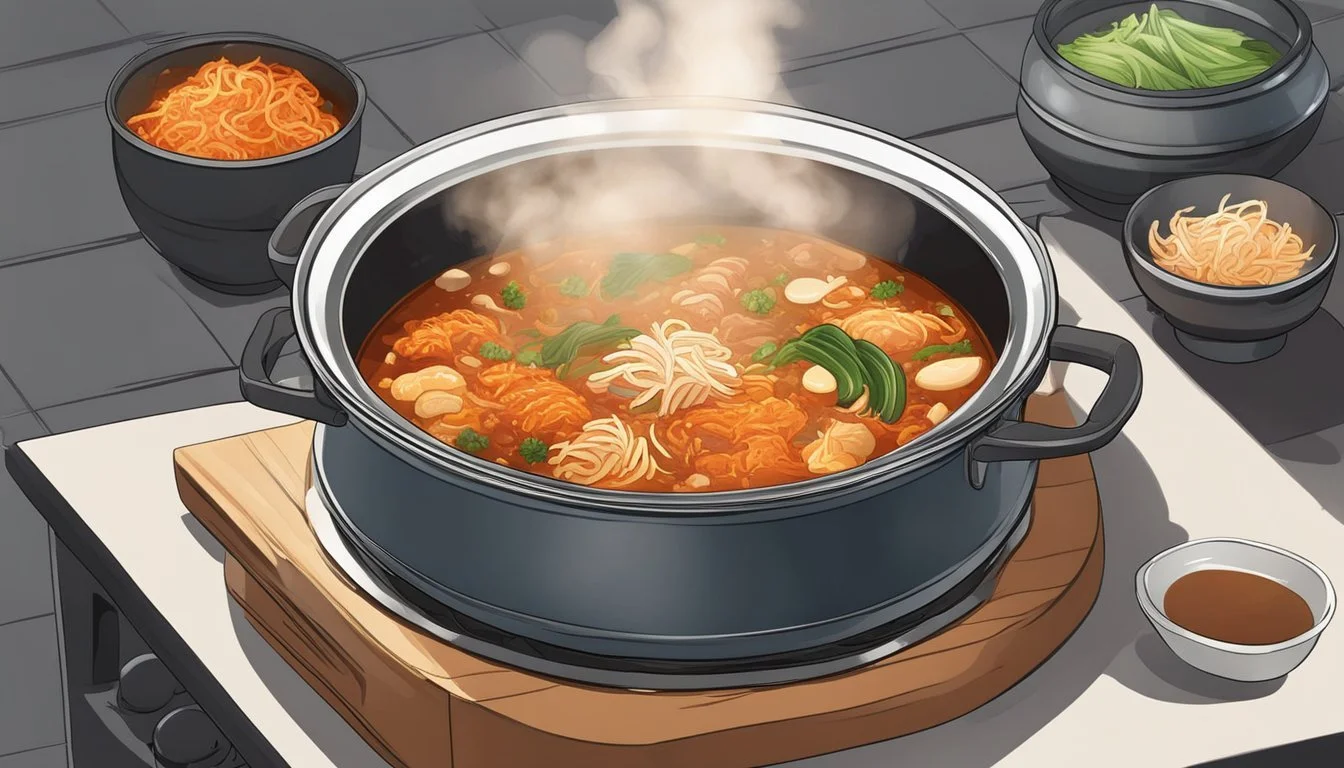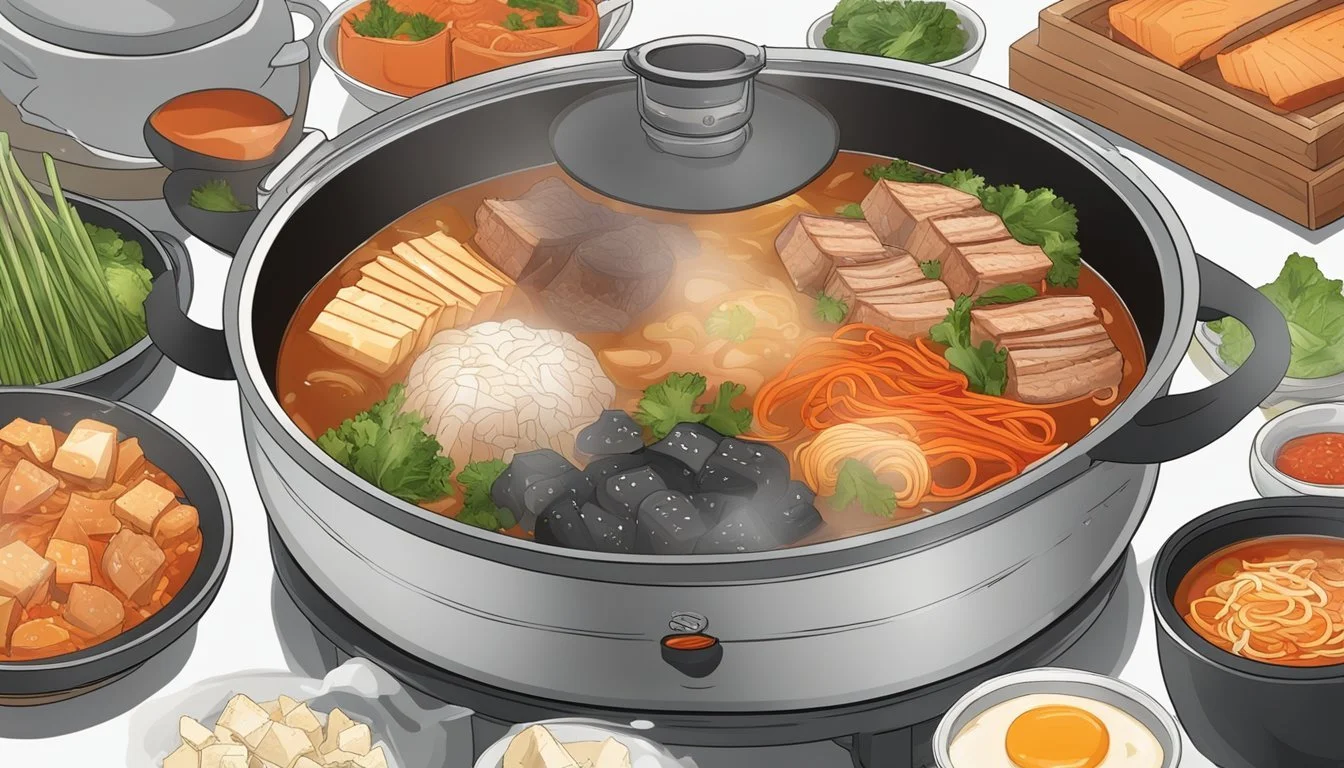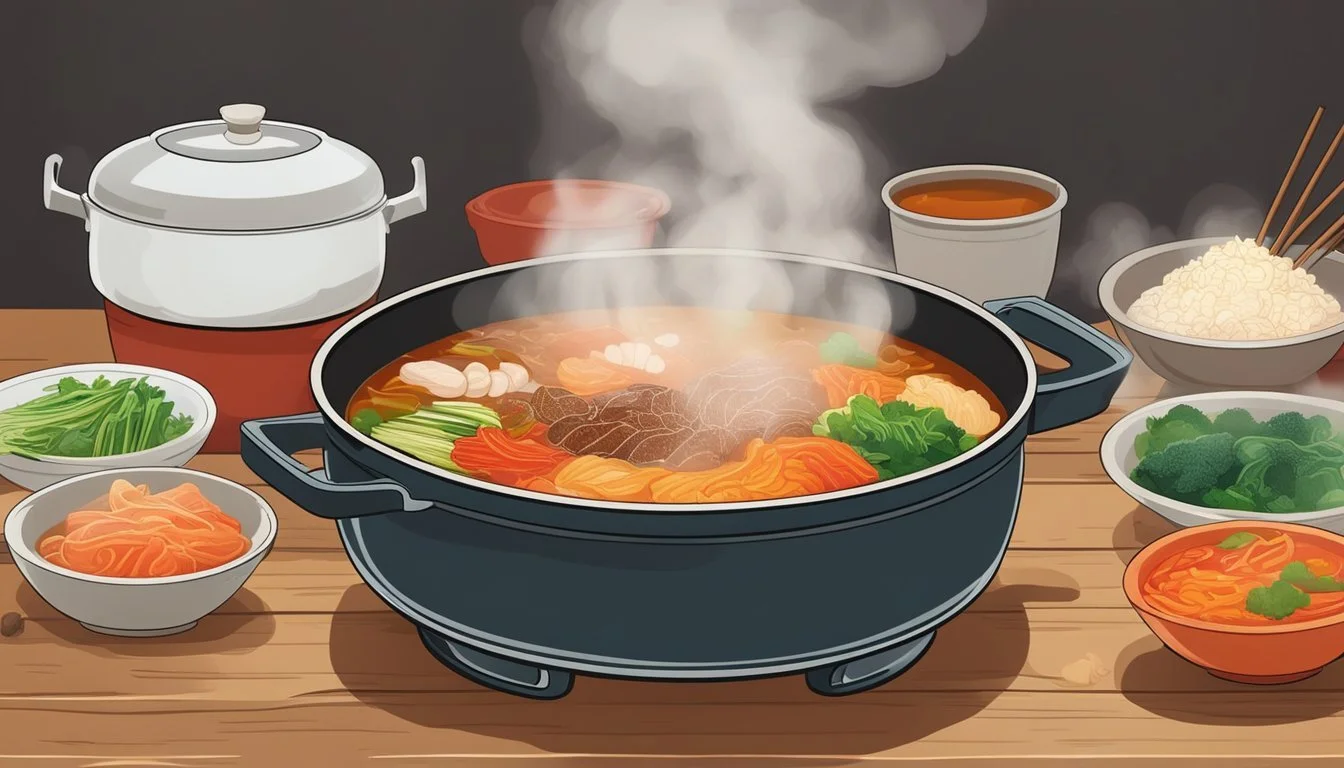Best Way to Reheat Kimchi Jjigae
Preserving Flavor and Zest
Kimchi jjigae, a traditional Korean stew, is renowned for its spicy, sour flavor that makes it a comforting meal, particularly in colder months. The stew's base, rich with the zest of fermented kimchi, is further enhanced by the inclusion of meats like pork belly and the silken subtlety of tofu. As with many hearty stews (What wine goes well with stews?), the flavor of kimchi jjigae can deepen over time, making leftovers a real treat. However, the key to enjoying leftover kimchi jjigae lies in the reheating process, which if done correctly, can preserve and even enhance its characteristic spicy and tangy taste.
Reheating kimchi jjigae calls for a gentle approach that ensures the heat penetrates the stew without altering its fundamental flavors. It's essential to strike the right balance between maintaining the robustness of the spices and the distinct tang offered by the kimchi. The concern for those who relish this dish lies in preserving the integrity of its texture and flavor profile while bringing it back to the suitable temperature that makes the experience as enjoyable as when it was first served.
The challenge in reheating lies in the stew's complexity of ingredients: the fermenting kimchi, tender meats, and delicate tofu. Each element must be considered to avoid overcooking the proteins or causing the kimchi to become too soft. Specific techniques and tips can ensure that the kimchi jjigae remains a vibrant and inviting dish, giving it the respect it deserves as a staple of Korean comfort food.
Understanding Kimchi Jjigae
Kimchi Jjigae, also known as Kimchi stew, is a cornerstone of Korean cuisine renowned for its vibrant flavor profile that harmoniously blends spicy, sour, and savory elements. This section walks you through the origins and cultural significance, the essential components that make up this beloved dish, and the nutritional value it offers.
Origins and Popularity
Kimchi Jjigae has its roots embedded deeply in Korean food traditions, establishing itself as a staple comfort food in both home-cooked meals and restaurant menus across Korea. Its popularity extends globally, with kimchi stew being a sought-after example of Korean recipes, reflecting the heart of Korean cuisine.
Key Ingredients
The main components of Kimchi Jjigae are as follows:
Kimchi: Preferably aged or fermented kimchi, which adds depth and a tangy taste to the stew.
Protein: Commonly used proteins include pork belly or tofu, providing richness and texture.
Soup base: A spicy and umami-rich soup, which is generally made with a combination of gochugaru (Korean red pepper flakes), gochujang (Korean red chili paste), garlic, onions, green onions, and sometimes sesame oil.
Other vegetables such as mushrooms or a variety of greens can be added according to preference, each contributing additional flavors and textures. Sugar can be included to balance the stew's dominant spicy notes.
Nutritional Value
The nutritional composition of Kimchi Jjigae is multifaceted, providing a balance of macronutrients:
Proteins: Sourced from ingredients like pork belly (or alternative proteins such as seafood) and tofu.
Fermented Vegetables: The kimchi is rich in probiotics, which are beneficial for gut health.
Macronutrients: A serving of Kimchi Jjigae typically contains a moderate amount of calories, with a balance of carbohydrates and fats, largely determined by the specific ingredients and portions used.
The stew's vitamin and mineral content, along with its probiotics, underscore its reputation as a nutritious option within the pantheon of Korean dishes.
Preparation Tips
When reheating kimchi jjigae, the key is to maintain its distinct spicy and tangy flavors. The following tips will guide readers through selecting the best ingredients for their stew, whether they're sticking with traditional meats or opting for vegetarian or vegan alternatives.
Selecting the Best Kimchi
The kimchi chosen should be well-fermented, as aged napa cabbage kimchi imparts a deeper flavor to the jjigae. One should look for kimchi that has a vibrant color and is stored in plenty of brine, which can be added to the stew for an extra kick of flavor.
Choosing the Right Proteins
Proteins like pork, beef, or chicken should be fresh and cut into bite-sized pieces to ensure even cooking. Traditional recipes often call for pork belly, which adds richness to the dish. Alternatives like canned tuna or spam are also popular for those looking for a quicker, yet flavorful, version of the recipe.
Vegetarian and Vegan Options
Vegetarians and vegans can substitute the meat with firm tofu, diced into cubes, or a variety of mushrooms such as shiitake or portobello for an earthy note. These additions provide not only protein but also textures that mimic meat's chewiness.
Enhancing Flavor and Texture
To elevate the jjigae, integrate gochujang (Korean chili paste) for a sweet and spicy profile, and gochugaru (Korean chili flakes) for heat. Adjust seasonings like salt, sugar, minced garlic, and black pepper to taste. A drizzle of sesame oil before serving can add a nutty aroma and finish the dish with a glossy texture.
Optimal Reheating Methods
To enjoy the full flavors of Kimchi Jjigae, it's essential to reheat it properly. This section will guide you through the best methods to ensure the stew retains its spicy and tangy taste.
Stovetop Technique
For a quick and even reheating process, the stovetop method is an excellent choice. Simply pour the Kimchi Jjigae into a saucepan and place it over medium heat. It is important to stir occasionally, allowing the heat to distribute evenly. As soon as the stew begins to simmer, lower the heat and continue to heat it for a couple of more minutes to prevent overcooking the ingredients.
Microwave Reheating
If convenience is a priority, using a microwave is a viable option. Transfer the Kimchi Jjigae into a microwave-safe bowl, cover it with a microwaveable lid or a sheet of plastic wrap to prevent splattering. Heat it on high for about two minutes, then stir. Continue to heat in 30-second intervals, stirring in between, until the desired temperature is achieved. This method can quickly reheat the stew without sacrificing too much flavor.
Using a Stone Pot
Reheating Kimchi Jjigae in a stone pot, or 'dolsot', is a traditional Korean method that not only warms the stew but can also enhance its taste. The thick walls of the stone pot provide gentle and steady heat, ideal for maintaining the essential flavors. Start by placing the stone pot on the stove over a low flame and gradually increase the heat, occasionally stirring. Once hot enough, serve it directly in the stone pot to keep the jjigae warm throughout the meal.
Pairing Suggestions
When reheating Kimchi Jjigae, it is important to complement its spicy and tangy flavors with appropriate side dishes and beverages. The right pairings can enhance the dining experience and balance the robustness of the stew.
Complementary Side Dishes
Kimchi Jjigae is traditionally served with a variety of banchan, or Korean side dishes. Here are some side dishes that harmonize well with the stew:
Steamed Rice: A bowl of plain steamed rice serves as a neutral canvas to absorb the stew's flavors and alleviate its spiciness.
Kimchi Pancake: For a twist on kimchi, an accompanying kimchi pancake offers a crisp texture and savory taste that pairs delightfully with the jjigae.
Other Banchan: A selection of small banchan such as spicy cucumber salad or bean sprouts can provide refreshing and crunchy contrasts.
Beverage Accompaniments
Choosing the correct beverages to accompany Kimchi Jjigae can enhance both the stew's and the drink's flavors. Consider the following:
Rice Wine: A traditional Korean rice wine, such as makgeolli, with its slightly sweet and sour profile, can complement the heat of the kimchi stew.
Water: Always ensure that water is available to cleanse the palate and quench any fiery heat after indulging in the stew.
Variations of Kimchi Jjigae
Kimchi Jjigae, also known as kimchi stew or soup, is a beloved Korean dish with a delightful balance of spicy and tangy flavors. This section explores the different takes on this traditional dish, highlighting how regional preferences and innovative additions create a rich tapestry of variations.
Regional Variations
In South Korea, the base of Kimchi Jjigae often includes tofu, pork, or sometimes tuna, reflecting the local availability of ingredients. Regions closer to the sea may incorporate seafood, enhancing the soup’s umami complexity. Japanese variations might adapt the recipe to include local ingredients or flavors, though traditional Korean Kimchi Stew remains popular in Japan as well.
Creative Twists
The versatility of Kimchi Jjigae invites creativity. Here are a few twists on the classic recipe:
Budae Jjigae: This "Army Stew" is a post-war hodgepodge creation incorporating American-style processed meats like spam and sausages, often with ramen noodles.
Kimchi Fried Rice: While not a stew, kimchi fried rice can be seen as a dry variation, repurposing similar flavors in a different texture profile.
Cheese: Adding cheese to Kimchi Jjigae creates a creamy, rich dimension that contrasts with the sharp kimchi flavors, popular for those who enjoy a milder heat.
Storing Kimchi Jjigae
Proper storage of kimchi jjigae, a traditional Korean kimchi stew, is crucial to maintaining its unique spicy and tangy taste while ensuring safety. Storing leftovers requires careful attention to temperature to preserve its quality.
Refrigeration Best Practices
It is recommended to store kimchi jjigae in the refrigerator immediately after it cools down. One should use an airtight container to prevent the stew from absorbing other odors and flavors from the refrigerator and also to avoid contamination. The stew should be consumed within 5 days for optimal taste, ensuring to check for any signs of spoilage prior to consumption. To maintain the best flavor:
Keep the stew at a stable temperature between 32-45°F (0-7°C).
Consume refrigerated kimchi jjigae within 5 days for best results.
Freezing and Thawing
For long-term storage, freezing kimchi jjigae is a viable option. To freeze kimchi stew:
Allow the stew to cool to room temperature.
Transfer into freezer-safe containers or bags.
Expel as much air as possible before sealing.
When ready to enjoy the kimchi jjigae, one should thaw it in the refrigerator for several hours or overnight to maintain the structure of the ingredients and flavor integrity. It's important to avoid thawing at room temperature as it can lead to bacterial growth. After thawing, the kimchi jjigae should be consumed within 24 hours for safety and quality.
Troubleshooting Common Issues
When reheating kimchi jjigae, certain issues can affect the dish's spicy and tangy profile. This section provides solutions to maintain the ideal taste and texture.
Avoiding Over-Fermentation
Kimchi jjigae can become overly sour if the kimchi used is too fermented. To prevent this:
Use kimchi that is moderately fermented, ensuring a balance of sourness.
Adjust the sourness by adding a pinch of sugar if the kimchi is too fermented.
Preventing Separation
Upon reheating, the stew's ingredients can separate, affecting texture and flavor:
Reheat the stew slowly on low heat, stirring occasionally to maintain consistency.
Before reheating, gently mix the leftovers to redistribute ingredients.
Balancing Flavors
The flavors of kimchi jjigae should be spicy, tangy, and slightly salty. If the balance is off:
Add a small amount of vinegar to enhance tanginess.
For excessive spice, stir in a teaspoon of sugar.
Dealing with Leftovers
Proper storage ensures kimchi jjigae maintains taste when reheated:
Store in an airtight container and refrigerate promptly to preserve freshness.
Consume reheated leftovers within 5 days to avoid spoilage.
By paying attention to these aspects of reheating kimchi jjigae, one can enjoy a dish that remains true to its origins every time it is served.
Kimchi Jjigae for Every Occasion
Kimchi Jjigae is a staple in Korean cuisine, known for its vibrant flavors. It's a versatile dish that fits various settings, from a simple family meal to a festive banquet.
Casual Family Meals
At the heart of Korean comfort food, Kimchi Jjigae reigns as an easy and quick option for family dinners. This spicy and tangy stew is perfect for those seeking a hearty meal that can be prepared without extensive effort. Side dishes like rice, seaweed, and stir-fried vegetables often accompany the stew, rounding out a balanced meal.
Ingredients for a family-style Kimchi Jjigae:
1 cup of kimchi (preferably fermented)
200g of pork belly or tofu
Mushrooms, onions, garlic (to taste)
1 tablespoon of gochujang (Korean chili paste)
1 tablespoon of soy sauce
Tofu or additional protein
Water or anchovy stock
Instructions:
Sauté kimchi and proteins.
Add water and seasonings.
Simmer and serve with rice.
Special Events and Gatherings
For special events, Kimchi Jjigae can serve as a showstopping main dish. In a banquet setting, the stew's layering of flavors makes it an ideal choice for a restaurant-quality experience at home. Its adaptability allows hosts to scale up the recipe, ensuring that each guest can savor the robust essence of this beloved Korean stew.
Presentation tips for gatherings:
Serve the jjigae in traditional Korean earthenware for authenticity.
Pair with a selection of Korean side dishes for a complete dining experience.
Solo Dining
Even when dining alone, Kimchi Jjigae provides a simple and satisfying meal. It can be made in smaller portions or in larger batches for meal prep throughout the week. Its savory taste and ease of reheating without losing flavor make Kimchi Jjigae a favored choice for solo diners seeking comfort in a bowl.
Tips for solo dining:
Store individual portions for convenience.
Reheat gently on the stove to maintain texture and taste.








